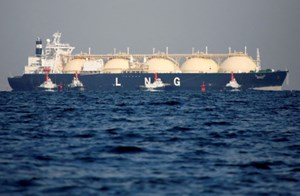Asia thermal coal prices get the blues from Europe and LNG
(Reuters) - Seaborne thermal coal prices in Asia have slumped to the lowest in two years as weakening demand in Europe and falling liquefied natural gas prices outweigh strong demand in the top-importing region.

The main grades of thermal coal from top exporters Indonesia and Australia extended losses last week, but relief may be in sight as the spot price of LNG gained, breaking a run of weekly declines stretching back to mid-December.
Indonesian coal with an energy content of 4,200 kilocalories per kg (kcal/kg) , as assessed by commodity price reporting agency Argus, dropped to $52.40 a metric ton in the seven days to June 16.
This was the lowest since April 2021 and the grade, which is popular in both top importers China and India, has now slid 57% from the 2022 high of $120.86, reached in March in the wake of global supply fears after Russian invaded Ukraine.
Australian coal with an energy content of 5,500 kcal/kg , another grade mainly bought by China and India, fell to $84.17 a metric ton last week, down 70% from its record high of $280.20 in March last year, and the lowest since July 2021.
High-grade Australian thermal coal, which is mainly bought by Japan, South Korea and Taiwan, fell to $118 a metric ton on Monday, according to price assessors globalCOAL, and is now trading at about a quarter of its record high.
It's worth noting that the grade of thermal coal that has seen the biggest price decline is the high energy content Australian fuel, which is the most exposed to competition from LNG in Japan, South Korea and Taiwan.
Spot LNG prices in Asia rose for the first week since mid-December in the seven days to June 16, jumping to $13.50 per million British thermal units (mmBtu), up 50% from the prior week's $9.00.
However, the $9.00 per mmBtu for the two weeks to June 9 was the lowest price since April 2021 and was also 87% below the record high of $70.50 per mmBtu reached in late August last year.
Higher natural gas prices in Europe are filtering through to Asia, even though demand for spot cargoes of the super-chilled fuel remains muted, especially in top importer Japan, largely as a result of its ample inventories.
European influence
Europe is also having an impact on Asian seaborne thermal coal prices as demand in Europe drops, which in turn sees regional swing suppliers such as South Africa pivot back to Asia.
Europe's seaborne thermal coal imports are expected to drop to the lowest in two years in June, with commodity analysts Kpler tracking arrivals of 4.38 million metric tons so far this month.
While this figure may still increase as more cargoes are assessed prior to the end of the month, it's certain that June's imports will be below May's 5.29 million metric tons and may not be much more than half the winter peak of 8.89 million from December.
South Africa supplied 1.53 million metric tons to Europe in December, but this is on track to drop to about 535,000 in June, according to Kpler data.
However, Asia is on track to import nearly 4 million metric tons from South Africa in June, up from the 2.28 million that arrived in December.
It's a similar dynamic for U.S. coal, with Europe on track to import 432,800 metric tons in June, down from 909,092 in December.
Asia's imports of U.S. coal are expected to be 2.06 million metric tons in June, up from 581,758 in December.
Asia's total imports of seaborne thermal coal are expected by Kpler to be 76.49 million metric tons in June, down from May's 80.01 million.
However, May and June are still the two strongest months in Kpler data going back to January 2017, and 2023 has seen four of the five strongest months for thermal coal imports on record.
It's clear that lack of demand isn't driving down Asian coal prices, rather it's cheaper spot LNG prices and the diversion of coal from Europe that are the main factors.
LNG prices may be recovering as peak summer demand arrives, but the relief this may bring to coal prices may be limited by the ongoing push by Atlantic Basin suppliers to sell into Asian markets.
Related News
Related News

- Shareholders’ Resolution: MOL to pay $668-MM dividend
- Credit Agricole says it will not fund two major LNG projects
- Aramco awards $7.7-B contracts to add 1.5 Bscfd of raw gas to Fadhili Gas Plant
- Japan's JERA suspends output at 4 gas-fired power plants to secure LNG stocks
- TotalEnergies: Papua LNG project requires 'more work' to reach final investment decision
- Technip Energies awarded a major LNG contract for the North Field South Project by QatarEnergy
- QatarEnergy to charter 19 new LNG vessels expanding fleet further
- Aramco awards $7.7-B contracts to add 1.5 Bscfd of raw gas to Fadhili Gas Plant
- Mabanaft announces successful acquisition of WESTFA Energy GmbH
- Shell exits China power market businesses, renews focus on natural gas



Comments